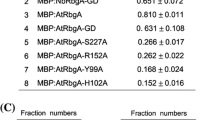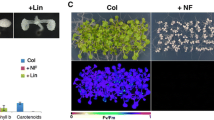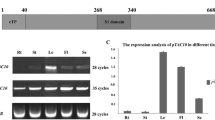Abstract
In the present study, we investigated protein characteristics and physiological functions of PRBP (plastid RNA-binding protein) in Nicotiana benthamiana. PRBP fused to green fluorescent protein (GFP) localized to the chloroplasts. Recombinant PRBP proteins bind to single-stranded RNA in vitro, but not to DNA in a double- or a single-stranded form. Virus-induced gene silencing (VIGS) of PRBP resulted in leaf yellowing in N. benthamiana. At the cellular level, PRBP depletion disrupted chloroplast biogenesis: chloroplast number and size were reduced, and the thylakoid membrane was poorly developed. In PRBP-silenced leaves, protein levels of plastid-encoded genes were significantly reduced, whereas their mRNA levels were normal regardless of their promoter types indicating that PRBP deficiency primarily affects translational or post-translational processes. Depletion of PRBP impaired processing of the plastid-encoded 4.5S ribosomal RNA, resulting in accumulation of the larger precursor rRNAs in the chloroplasts. In addition, PRBP-deficient chloroplasts contained significantly reduced levels of mature 4.5S and 5S rRNAs in the polysomal fractions, indicating decreased chloroplast translation. These results suggest that PRBP plays a role in chloroplast rRNA processing and chloroplast development in higher plants.







Similar content being viewed by others
References
Ahn CS, Pai H-S (2008) Physiological function of IspE, a plastid MEP pathway gene for isoprenoid biosynthesis, in organelle biogenesis and cell morphogenesis in Nicotiana benthamiana. Plant Mol Biol 66:503–517
Barkan A (1993) Nuclear mutants of maize with defects in chloroplast polysome assembly have altered chloroplast RNA metabolism. Plant Cell 5:389–402
Barkan A (1998) Approaches to investigating nuclear genes that function in chloroplast biogenesis in land plants. Meth Enzymol 297:38–57
Beick S, Schmitz-Linneweber C, Williams CR, Jensen B, Barkan A (2008) The pentatricopeptide repeat protein PPR5 stabilizes a specific tRNA precursor in maize chloroplasts. Mol Cell Biol 28:5337–5347
Beligni MV, Mayfield SP (2008) Arabidopsis thaliana mutants reveal a role for CSP41a and CSP41b, two ribosome-associated endonucleases, in chloroplast ribosomal RNA metabolism. Plant Mol Biol 67:389–401
Bellaoui M, Gruissem W (2004) Altered expression of the Arabidopsis ortholog of DCL affects normal plant development. Planta 219:819–826
Bellaoui M, Keddie JS, Gruissem W (2003) DCL is a plant-specific protein required for plastid ribosomal RNA processing and embryo development. Plant Mol Biol 53:531–543
Berg M, Rogers R, Muralla R, Meinke D (2005) Requirement of aminoacyl-tRNA synthetases for gametogenesis and embryo development in Arabidopsis. Plant J 44:866–878
Bisanz C, Bégot L, Carol P, Perez P, Bligny M, Pesey H, Gallois JL, Lerbs-Mache S, Mache R (2003) The Arabidopsis nuclear DAL gene encodes a chloroplast protein which is required for the maturation of the plastid ribosomal RNAs and is essential for chloroplast differentiation. Plant Mol Biol 51:651–663
Bollenbach TJ, Lange H, Gutierrez R, Erhardt M, Stern DB, Gagliardi D (2005) RNR1, a 3′-5′ exoribonuclease belonging to the RNR superfamily, catalyzes 3′ maturation of chloroplast ribosomal RNAs in Arabidopsis thaliana. Nucleic Acids Res 33:2751–2763
Bollenbach TJ, Sharwood RE, Gutierrez R, Lerbs MS, Stern DB (2009) The RNA-binding proteins CSP41a and CSP41b may regulate transcription and translation of chloroplast-encoded RNAs in Arabidopsis. Plant Mol Biol 69:541–552
Cho HS, Lee SS, Kim KD, Kim SJ, Hwang I, Lim JS, Park YI, Pai H-S (2004) DNA gyrase is involved in chloroplast nucleoid partitioning. Plant Cell 16:2665–2682
Constan D, Patel R, Keegstra K, Jarvis P (2004) An outer envelope membrane component of the plastid protein import apparatus plays an essential role in Arabidopsis. Plant J 38:93–106
Cushing DA, Forsthoefel NR, Gestaut DR, Vernon DM (2005) Arabidopsis emb175 and other ppr knockout mutants reveal essential roles for pentatricopeptide repeat (PPR) proteins in plant embryogenesis. Planta 221:424–436
Fuller-Pace FV (2006) DExD/H box RNA helicases: multifunctional proteins with important roles in transcriptional regulation. Nucleic Acids Res 34:4206–4215
Grishin NV (1998) The R3H motif: a domain that binds single-stranded nucleic acids. Trends Biochem Sci 23:329–330
Holloway SP, Herrin DL (1998) Processing of a composite large subunit rRNA. Studies with Chlamydomonas mutants deficient in maturation of the 23S-like rRNA. Plant Cell 10:1193–1206
Iost I, Dreyfus M (2006) DEAD-box RNA helicases in Escherichia coli. Nucleic Acids Res 34:4189–4197
Ivanov B, Khorobrykh S (2003) Participation of photosynthetic electron transport in production and scavenging of reactive oxygen species. Antioxid Redox Signal 5:43–53
Jeon Y, Hwang A-R, Hwang I, Pai H-S (2010) Silencing of NbCEP1 encoding a chloroplast envelope protein containing 15 leucine-rich-repeats disrupts chloroplast biogenesis in Nicotiana benthamiana. Mol Cells 29:175–183
Jiang W, Fu F-L, Zhang S-Z, Wu L, Li W-C (2010) Cloning and characterization of functional trehalose-6-phosphate synthase gene in maize. J Plant Biol 53:134–141
Kang K, Lee K, Park S, Lee S, Kim YS, Back K (2010a) Overexpression of rice ferrochelatase I and II leads to increased susceptibility to oxyfluorfen herbicide in transgenic rice. J Plant Biol 53:291–296
Kang YW, Lee JY, Jeon Y, Kim M, Cheong GW, Pai H-S (2010b) In vivo effects of NbSiR silencing on chloroplast development in Nicotiana benthamiana. Plant Mol Biol 72:569–583
Keus RJ, Stam NJ, Zwiers T, de Heij HT, Groot GS (1984) The nucleotide sequences of the genes coding for tRNAArgUCU, tRNAArgACG and tRNAAsnGUU on Spirodela oligorhiza chloroplast DNA. Nucleic Acids Res 12:5639–5646
Kim M, Ahn JW, Song K, Paek KH, Pai H-S (2002) Forkhead-associated domains of the tobacco NtFHA1 transcription activator and the yeast Fhl1 forkhead transcription factor are functionally conserved. J Biol Chem 277:38781–38790
Kim M, Lim JH, Ahn CS, Park K, Kim GT, Kim WT, Pai H-S (2006) Mitochondria-associated hexokinases play a role in the control of programmed cell death in Nicotiana benthamiana. Plant Cell 18:2341–2355
Kim JS, Park SJ, Kwak KJ, Kim YO, Kim JY, Song J, Jang B, Jung C-H, Kang H (2007) Cold shock domain proteins and glycine-rich RNA-binding proteins from Arabidopsis thaliana can promote the cold adaptation process in E. coli. Nucleic Acids Res 35:506–516
Kössel H, Edwards K, Koch W, Langridge P, Schiefermayr E, Schwarz Z, Strittmatter G, Zenke G (1982) Structural and functional analysis of an rRNA operon and its flanking tRNA genes from Zea mays chloroplasts. Nucleic Acids Symp Ser 11:117–120
Leal-Klevezas DS, Martínez-Soriano JP, Nazar RN (2000) Cotranscription of 5S rRNA-tRNA(Arg)(ACG) from Brassica napus chloroplasts and processing of their intergenic spacer. Gene 253:303–311
Lee HW, Kim J (2010) Ectopic expression of LBD18/ASL20 results in arrest of plant growth and development with repression of AINTEGUMENTA and PLETHORA genes. J Plant Biol 53:214–221
Lee JY, Lee HS, Wi SJ, Park KY, Schmit AC, Pai H-S (2009) Dual functions of Nicotiana benthamiana Rae1 in interphase and mitosis. Plant J 59:278–291
Ruppel NJ, Hangarter RP (2007) Mutations in a plastid-localized elongation factor G alter early stages of plastid development in Arabidopsis thaliana. BMC Plant Biol 7:37
Sancenón V, Puig S, Mira H, Thiele DJ, Peñarrubia L (2003) Identification of a copper transporter family in Arabidopsis thaliana. Plant Mol Biol 51:577–587
Schmitz-Linneweber C, Williams-Carrier RE, Williams-Voelker PM, Kroeger TS, Vichas A, Barkan A (2006) A pentatricopeptide repeat protein facilitates the trans-splicing of the maize chloroplast rps12 pre-mRNA. Plant Cell 18:2650–2663
Schultz J, Milpetz F, Bork P, Ponting CP (1998) SMART, a simple modular architecture research tool: identification of signaling domains. Proc Natl Acad Sci USA 95:5857–5864
Strittmatter G, Kössel H (1984) Cotranscription and processing of 23S, 4.5S and 5S rRNA in chloroplasts from Zea mays. Nucleic Acids Res 12:7633–7647
Tzafrir I, Pena-Muralla R, Dickerman A, Berg M, Rogers R, Hutchens S, Sweeney TC, McElver J, Aux G, Patton D, Meinke D (2004) Identification of genes required for embryo development in Arabidopsis. Plant Physiol 135:1206–1220
Uwer U, Willmitzer L, Altmann T (1998) Inactivation of a glycyl-tRNA synthetase leads to an arrest in plant embryo development. Plant Cell 10:1277–1294
Wall MK, Mitchenall LA, Maxwell A (2004) Arabidopsis thaliana DNA gyrase is targeted to chloroplasts and mitochondria. Proc Natl Acad Sci USA 101:7821–7826
Walter M, Kilian J, Kudla J (2002) PNPase activity determines the efficiency of mRNA 3′-end processing, the degradation of tRNA and the extent of polyadenylation in chloroplasts. EMBO J 21:6905–6914
Watkins KP, Kroeger TS, Cooke AM, Williams-Carrier RE, Friso G, Belcher SE, van Wijk KJ, Barkan A (2007) A ribonuclease III domain protein functions in group II intron splicing in maize chloroplasts. Plant Cell 19:2606–2623
Williams PM, Barkan A (2003) A chloroplast-localized PPR protein required for plastid ribosome accumulation. Plant J 36:675–686
Williams AJ, Werner-Fraczek J, Chang IF, Bailey-Serres J (2003) Regulated phosphorylation of 40S ribosomal protein S6 in root tips of maize. Plant Physiol 132:2086–2097
Yamamoto YY, Puente P, Deng XW (2000) An Arabidopsis cotyledon-specific albino locus: a possible role in 16S rRNA maturation. Plant Cell Physiol 41:68–76
Yang J, Schuster G, Stern DB (1996) CSP41, a sequence-specific chloroplast mRNA binding protein, is an endoribonuclease. Plant Cell 8:1409–1420
Zanetti ME, Chang IF, Gong F, Galbraith DW, Bailey-Serres J (2005) Immunopurification of polyribosomal complexes of Arabidopsis for global analysis of gene expression. Plant Physiol 138:624–635
Acknowledgments
This research was supported by Mid-career Researcher Program (No. 20100026168 and No. 20100000314) and Plant Signaling Network Research Center (No. 2010-0001462), both of which are funded by National Research Foundation of Korea.
Author information
Authors and Affiliations
Corresponding author
Additional information
GenBank accession number: HM236482.
Electronic supplementary material
Below is the link to the electronic supplementary material.
Supplemental
Fig.1. Sequence alignment of PRBP proteins. a The PRBP protein structure showing the N-terminal transit peptide (TP). b Amino acid sequences of PRBP and its homologs from tobacco (PRBP-Nt), tomato (PRBP-Le), and Arabidopsis (PRBP-At) were aligned. The residues that are conserved between the sequences are boxed in black or light gray based on the degree of conservation. The overline indicates the transit peptide. c Amino acid sequences of the N-termini of PRBP, PRBP-At, and the putative organellar DEAD-box RNA helicases of Arabidopsis (At2g07750 and At1g63250) were aligned (PDF 48 KB)
Supplemental
Fig.2. Expression profiles of Arabidopsis PRBP (At2g37920) in diverse tissues based on Genevestigator analysis (http://www.genevestigator.com/). Expression is expressed relative to the transcript level in roots (PDF 116 KB)
Supplemental
Fig.3. RNA gel blot analysis using the 163-nucleotide probe. Positions of the PCR-amplified probes (probes A and B) are marked by thick lines under the rrn operon. The size of the ~3.2 kb 23S–4.5S precursor and the ~2.9 kb mature 23S rRNA is shown underneath as thin lines. The RNA gel blot shown in Fig. 7c was hybridized with the probe B containing the 163-nucleotide region between the tRNA-Ala (trnA) mature 3′-end and the 23S rRNA mature 5′-end. The probe B recognized only the ~3.2 kb 23S–4.5S precursor (PDF 54 KB)
Supplemental
Fig.4. PRBP binding to the 23S–4.5S rRNA precursor Increasing concentrations of His:PRBP fusion protein (0, 10, 50, and 100 pmol) were incubated with two different radiolabeled ssRNA probes (20 pM) derived from the 23S–4.5S rRNA precursor sequence. Bound (B) and unbound (U) RNAs were resolved on a native polyacrylamide gel. Only part of the N. benthamiana chloroplast rrn operon is presented. Positions of the ssRNA probes (probes A and B) are marked by thick lines under the operon. The probes contain all or part of the 163-nucleotide region between the 23S rRNA mature 3′-end and the 4.5S rRNA mature 5′-end in the rrn operon (PDF 38 KB)
Supplemental
Fig.5. Nucleolar pre-rRNA processing. a Structure of the primary 35S pre-rRNA. The mature 18S, 5.8S, and 25S rRNA sequences are flanked by the external transcribed sequences 5′-ETS and 3′-ETS and separated by internal transcribed spacers ITS1 and ITS2. Positions of probes in the 35S rRNA primary transcript are marked by the thick lines. b RNA gel blot analysis was performed with total RNA isolated from the leaves of the TRV, TRV:PRBP(N), and TRV:PRBP(C) lines. The RNA gel blots (15 μg total RNA per lane) were hybridized with probes for 18S, 5.8S, and 25S rRNAs. An ethidium bromide (EtBr)-stained gel shows total ribosomal RNA. c RNA gel blot analysis was performed with total RNA isolated from TRV and TRV:PRBP(N) leaves using end-labeled ITS1 and ITS2 probes. d Absorbance profile of ribosomes at 254 nm. Ribosomes were purified from leaves of TRV and TRV:PRBP(N) lines by sucrose density gradient ultracentrifugation. Positions of the ribosome small subunits (40S), large subunits and monosomes (60S/80S), and polysomes are marked (PDF 245 KB)
Rights and permissions
About this article
Cite this article
Park, YJ., Cho, HK., Jung, H.J. et al. PRBP plays a role in plastid ribosomal RNA maturation and chloroplast biogenesis in Nicotiana benthamiana . Planta 233, 1073–1085 (2011). https://doi.org/10.1007/s00425-011-1362-7
Received:
Accepted:
Published:
Issue Date:
DOI: https://doi.org/10.1007/s00425-011-1362-7




